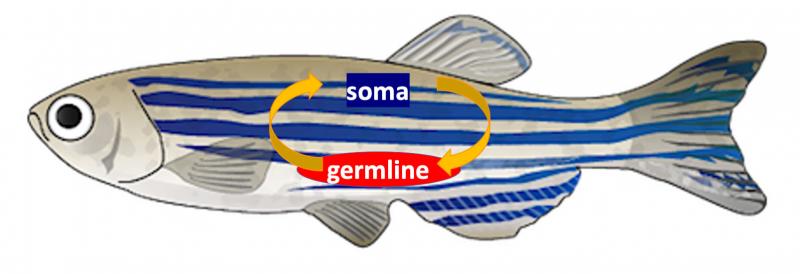A long-standing dogma is that resource allocation between reproduction and survival is driving the evolution and phenotypic manifestation of organismal ageing. These views have been challenged by experimental findings that lifespan can be increased dramatically without a cost to fecundity. However, we recently suggested that an increase in somatic lifespan may come at the expense of reduced DNA maintenance and repair in the germ line as a hidden cost of reproduction or the 'Expensive Germline hypothesis' (4). Repair and maintenance mechanisms are present in the germ line and the soma and contribute to the key processes involved in ageing. However, how these somatic and germline mechanisms are regulated and how they interact is still poorly understood. The bulk of our understanding about the interactions between the germ line and the soma comes from studies of invertebrates. However, there is a profound limitation to these studies because the soma of one of the key invertebrate species in ageing research, C. elegans, is mitotically inactive. While this trait renders C. elegans an ideal study system for many aspects of ageing biology, it does not reflect the processes occurring in most vertebrates and in vertebrate males in particular. Male vertebrates not only maintain a germ line that continues mitotic and meiotic divisions, but also a mitotically dividing soma throughout life. We therefore investigated the importance of the germ line for somatic maintenance in male zebrafish, Danio rerio (Chen et al.).

Figure: The role of the interaction of the germ line and the soma for organismal ageing and testing the ‘expensive germline hypothesis’.
The removal of the germ line has previously been suggested to result in extended lifespan in a range of species. But no study had ever looked at the response to any genotoxic stress in germline-free and germline carrying organisms. We used morpholino knockdowns to experimentally generate germline-free male zebrafish. In a split-clutch approach, we compared germline-free males to their wildtype control and control-morpholino injected germline-carrying brothers for signs of somatic growth and maintenance with and without exposure to genotoxic stress. We exposed half of the males in all three treatments to a sub-lethal dose of gamma-radiation introducing DNA damage in the germline and the soma. We tested the impact of the radiation treatment on the germline by setting up males from both treatments with wildtype females for natural spawning repeatedly after irradiation. We observed a clear dip in fertilisation success, embryo survival and embryo normality shortly after irradiation and a continuous recovery over time suggesting a successful repair in the germ line.
To test for the effects of irradiation in germline-free and germline-carrying males, we used a somatic growth assay, where we cut off 50% of the caudal fin shortly after irradiation in control males at the same time and measured fin regrowth over time. Without radiation treatment, we observed no difference in regrowth rate between germline-free and germline carrying fish. However, in irradiated fish, germline-free males showed a significantly faster regrowth already a few days after irradiation and the difference between germline-free and germline-carrying fish increased more as days passed. This observation suggests that the germ line plays a key role in somatic growth and maintenance and more so under stressful conditions. We also studied the somatic growth and maintenance in germline-free fish with and without irradiation by assessing the number of cells exhibiting DNA double- and single-strand breaks as measured by TUNEL assays seven days after irradiation. Three somatic tissues were tested (kidney, intestines and muscle) and where possible the testes. Without irradiation, TUNEL-positive cells were more abundant in germline-carrying fish compared to germline-free fish in two of the three somatic tissues (not muscle), but after irradiation, TUNEL-positive cells increased slightly in abundance in germline-free fish, but decreased in abundance in germline-carrying controls in the same treatments.
Overall, our results support the idea that the germ line plays a key role in the growth and maintenance of the soma, and that the relationship may at least partly be based on a trade-off in maintenance between the two. Under such a scenario, the removal of the germ line would free resources to be channeled towards somatic maintenance. An alternative interpretation is that the absence of the germ line results in a lack of germline signaling to the soma, resulting in a blocked downregulation of repair genes in the soma in germline-free fish. Our current research aims at understanding the underlying mechanisms observed in this study.


































